Years ago, while on a trip to the west coast, I heard that a local Home Depot home improvement store stocked ‘blue’ metal halide lamps. The person telling me this had not actually seen them, but a friend of his had. I did not have the opportunity to confirm the story, but figured if it was true, that all Home Depot stores would eventually stock them. As you have likely guessed, this story falls into the Urban Legend category as I have never seen any sort of specialty metal halide lamp in any of HD’s stores. However, I can say that Home Depot sells small compact fluorescent lamps (CFLs) that appear to be ‘actinic’ lamps. Feit Electric (Pico Rivera, California) markets these CF lamps as ‘EcoBulb PartyBulbs’. They are advertised to use only 13 watts and have a life expectancy of 7 years/8,000 hours.
These lamps are small in size, contain an internal ballast and have a standard ‘screw-in’ mogul base. But are these suitable for lighting aquaria? How much light do they produce, and how does the spectrum compare to a ‘true’ actinic lamp? There are other lamp colors available – a ‘black light’, green, yellow, red as well as warm white, soft white and 6500K daylight. At only $4.99 each (Hawaii price), I picked up several for testing purposes. The 13 watt 6500K ‘daylight’ CFLs were found at the local Wal-Mart and I picked up a package for testing as well.
Feit’s website (www.feit.com) offers little information on these lamps, and certainly no spectral data other than stating the obvious color. Once again, I realized that analyses of these lamps would require use of quite a bit of laboratory equipment and software.

Figure 2. Spectral analysis reveals Feit’s black light generates mostly UV-A radiation – just as it should.
The first order of business established the spectral quality of each of these lamps. If these lamps were merely coated with a material that selectively filtered the output of a, say, warm white lamp, this would be immediately obvious. On the other hand, if the lamps’ phosphors were those to produce relatively narrow bandwidths, further testing could begin.
Spectral Quality
Spectral quality of these lamps was measured with an Ocean Optics USB2000 spectrometer (see the ‘Testing Protocol’ section below for details).
Note: Disregard the y-axis (Relative Intensity) in the following ‘Spectral Quality’ charts. It is irrelevant as the distance of the lamp above the spectrometer patch cord was not standardized. Intensity (reported as Photosynthetically Active Radiation, and tested under standardized conditions) will follow later in this article.
Feit Ultraviolet-A (or Black Light) Compact Fluorescent Lamp
As Figure 2 shows, this lamp is a true ‘black light’ and most of its output is in the UV-A portion of the spectrum.
| Color | Percent |
|---|---|
| UV-A | 92.0% |
| Violet | 3.9% |
| Blue | 1.7% |
| Blue-Green | 0.1% |
| Green-Blue | 0.2% |
| Green | 0.3% |
| Yellow-Green | 0.7% |
| Yellow | 0.2% |
| Orange | 0.1% |
| Red | 0.9% |

Figure 4. Only minor differences exist in the spectral outputs of the Feit and ProLume black lights.
ProLume 15 watt Black Light
The spectral qualities of the ProLume CFLs are practically the same as the Feit lamps. See Figure 4.
Feit Blue Compact Fluorescent Lamp
This lamp was of the most interest to me personally. Results of testing showed it to produce most of its radiation in the violet and blue bandwidths.
| Color | Percent |
|---|---|
| Violet | 21.7% |
| Blue | 71.0% |
| Green-Blue | 3.0% |
| Blue-Green | 2.3% |
| Green | 0.7% |
| Yellow-Green | 0.8% |
| Yellow | 0.1% |
| Orange | 0.0% |
| Red | 0.3% |
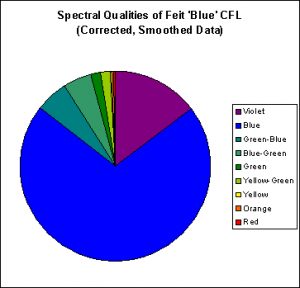
Figure 6. As expected, the ‘blue’ lamp produces mostly violet and blue light. More than 95% of this lamp’s output is potentially available to promote photosynthesis, thus 95% of the PAR value is actually Photosynthetically Useable Radiation (PUR).
Feit Green Compact Fluorescent Lamp
This is an interesting lamp, and this lamp is not generally offered to aquarists. Very little of its output is absorbed by Chlorophyll a, Chlorophyll c2, or the accessory pigment peridinin, all of which are found in corals’ symbiotic algae (zooxanthellae). However, it may have an application for hobbyists, as we will discuss later.
| Color | Percent |
|---|---|
| Violet | 0.6% |
| Blue | 2.1% |
| Green-Blue | 1.5% |
| Blue-Green | 16.0% |
| Green | 34.8% |
| Yellow-Green | 39.5% |
| Yellow | 3.5% |
| Orange | 1.1% |
| Red | 1.0% |
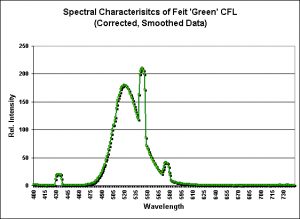
Figure 7. Almost all of the light produced by this lamp is outside of the absorption ranges of chlorophyll and peridinin, but green light is known to induce orange fluorescence in corals containing the proper pigments.
Feit White ‘Daylight’ (6500K lamp) Compact Fluorescent Lamp
The output of a ‘daylight’ lamp is not as flattering to those of us vainly observing our skin tones in a mirror. Its output is harsh in comparison to ‘warm’ or ‘soft’ white fluorescent lamps, thus they are considered something of a specialty lamp.
However, I found these at Wal-Mart in a package of three for a reasonable price.
| Color | Percent |
|---|---|
| Violet | 6.7% |
| Blue | 27.0% |
| Green-Blue | 5.5% |
| Blue-Green | 5.6% |
| Green | 3.9% |
| Yellow-Green | 22.8% |
| Yellow | 2.5% |
| Orange | 5.0% |
| Red | 21.0% |
Feit Soft White Compact Fluorescent Lamp (~2700K)
This lamp produces a warm, pinkish light and is generally preferred for use in living areas and bathrooms. These produce less blue, but more red, light than ‘daylight’ lamps.
| Color | % |
|---|---|
| Violet | 7.2% |
| Blue | 8.8% |
| Green-Blue | 3.5% |
| Blue-Green | 1.6% |
| Green | 0.4% |
| Yellow-Green | 27.3% |
| Yellow | 4.6% |
| Orange | 7.8% |
| Red | 38.8% |

Figure 11. The soft white lamp, when compared to the daylight lamp, lacks light in the violet and blue portions of the spectrum.
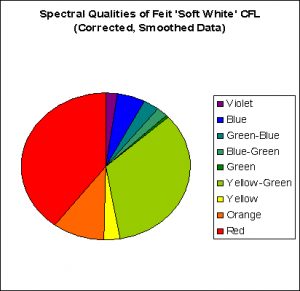
Figure 12. This lamp is probably not a good choice for reef aquaria – it lacks blue, and has too much red.
Lamp Intensity
The amount of radiation (Photosynthetically Active Radiation, or PAR, reported in units of micromol per square meter per second, or molm²sec) was determined through use of a LiCor quantum meter and sensor. See the ‘Testing Protocol’ section below for details.
PAR varied wildly among types of lamps. See Figure 13.
We should recall that the light output of fluorescent lamps is dependent upon operating temperature. During testing, it was noted that light intensity increased for the first minute or two of operation then fell before reaching a steady-state plateau. This indicates that passive cooling is insufficient to keep the lamp output at its maximum.
Horizontal versus Vertical Operation
These lamps are ‘universal burn lamps’, meaning that they can be operated horizontally, vertically, or any angle in between. I was interested in which position (vertical or horizontal) would ‘throw’ the most light. See Figure 14. While I had the lamp in the horizontal position, I placed a hemispherical aluminum reflector above it and evaluated its effect on focusing light downwards (shown also in Figure 14).
A crude aluminum reflector effectively focused PAR, but not to levels useful for illuminating most reef aquaria.
As can be seen, the reflector effectively doubled the amount of light falling upon the PAR sensor. Still, a PAR value of only 64 molm²sec would be of little practical use for most reef aquaria. But what of other types of reflectors?
Effects of Pendent Reflector Geometry on Light Intensity
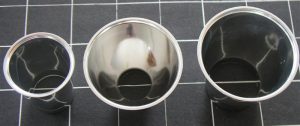
Figure 15. Polished aluminum reflectors for CF lamps. Surprisingly, the reflector on the right (Reflector ‘C’) delivered the best performance.
I purchased the reflectors shown in Figure 15 during a trip to Honolulu a few years ago, and I have unfortunately lost all information on them. They were sold ‘loose’ (not in a box), and I suspect these can be obtained through any reasonably-well stocked lighting store.
The sizes of the reflectors in Figure 15 are (from left to right):
- Reflector A: 2.5″ diameter X 3.25″ high (top diameter is 1.75″)
- Reflector B: 3.75″ diameter X 2.75″ high (top diameter is 1.375″)
- Reflector C: 3.75″ diameter X 3.75″ high (top diameter is 2.25″)
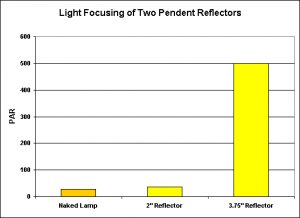
Figure 16. Effects of reflectors on light intensity using the ‘blue’ Feit lamp.
Of these, the last on the list was most effective in that the top diameter is large enough to allow more latitude in positioning over the lamp (the diameters of these CFLs are about 1.75″). I found the best light intensity when the top of the reflector was even with the bottom of the ceramic base.
Using the same reflector (‘C’) on the Daylight 6500K lamp, I found the maximum intensity was also increased by an order of one magnitude (that is, from about 95 to almost 1,100 molm²sec).
Power Consumption
These lamps are advertised to consume 13 watts of energy, and replace a 60 watt incandescent lamp. The claims of energy consumption are reasonable (if slightly overstated). Only the Daylight and Soft White lamps produce enough light to be true replacements for 60 watt incandescent lamps.
Heat Transfer
Fluorescent lamps are designed to operate at relatively narrow ranges. Although the advertising tells us the lamp can operate from -10°F to 140°F, this does not necessarily mean that light production is at its highest. Light production is dependent upon pressure of the mercury vapor within the lamp, and pressure is dependent upon temperature. Many fluorescent lamps are designed to operate at a temperature of about 100°F. In any case, these lamps operate at a temperature of ~69°F to ~165°F, depending upon where on the lamp the temperature is taken with the non-contact ‘heat’ detector. Figure 18 shows transfer of heat to an I-button temperature data logger (this is the difference, or delta, between a control data logger placed away from the lamp and the data logger placed 3.5″ below the CF lamp).
Is this really important? See article for details.
After data were gathered for Figure 18, I experimented with various reflectors, and found that the lamps can be further removed from the aquarium water surface while increasing (focusing) the amount of PAR. I did not repeat the temperature experiment but feel confident that heat transfer will not be a serious concern when using pendant-type reflectors, although some means of cooling should be provided.
Lamp Life
Manufacturers base lamp life on tests meeting certain criteria and is generally calculated when the number of failures reaches a given percentage (usually 50%) in a large sample of lamps. The manufacturer does not care if the amount of light produced by the lamp has dropped, only that the lamp still ‘burns’.
Feit prominently advertises their CFL lamps will last 7 years, but the fine print tells us this is based on ‘household’ usage of 3 hours per day (or 7,665 hours, which is reasonably close to the advertised 8,000 hours of expected life). Realistically, these lamps will lose intensity and likely have a useable life expectancy similar to other fluorescent lamps (perhaps 6-12 months when burned for 12 hours per day, or 2,000-4,000 hours).
All fluorescent lamps lose intensity partially due to ‘sputtering’ – the vaporization of the electrodes which coats the internal surfaces with metallic materials. This causes the dark rings at the ends of standard fluorescent tubes.
Disposal of Used Lamps
All fluorescent, metal halide and mercury vapor lamps contain the element mercury (Hg). The amount of mercury is very small and recommended disposal procedures are often the same as those for regular incandescent bulbs, however, use of any of the internet search engines can provide local regulations. The EPA does not regulate disposal of mercury lamps unless you generate a lot of used lamps.
Discussion and Conclusions
I did not have high expectations for these lamps when I purchased them. But even after making close to 100,000 light measurements over the course of the last 15 years or so, I realize that I can still be surprised.
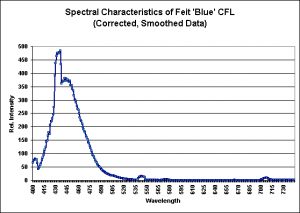
Figure 19. Compare the spectral quality of this ‘blue’ Feit lamp to that of an actinic lamp (shown in Figure 20).
Although the Feit ‘blue’ lamp does not possess the same spectral characteristics of a ‘true’ actinic lamp, it is remarkable close. See Figures 19 and 20.
However, the light quality of the daylight lamp is about equal to any daylight lamp on the market. The Feit ‘green’ lamp likely has applications when one wishes to mimic turbid reef environments, though they will have to be mixed with daylight and/or actinic lamps to gain PAR and aesthetic value. Interestingly, the output of the green lamp possesses wavelengths known to enhance red and orange fluorescence in at least some coral species. Black lights have applications in specialty aquaria, especially where the goal is to showcase most any of the fluorescent pigments found in so many corals.
The amount of PAR produced by the daylight and soft white lamps is very good for a low-wattage lamp. The green and blue lamps, when not housed in a reflector, produced a disappointing amount of light. However, selective use of a quality reflector and lamp positioning makes these lamps worthy of your attention. It is not difficult to imagine a number of these lamps wired in series and housed in proper reflectors projecting enough light into a shallow nano-reef or specialty tank (such as a refugium or frag tank). Such a luminaire would be inexpensive to build and operate, and lamp replacement cost would be minimal. These are factors we rarely encounter when dealing with reef aquaria and could be easily exploited to the advantage of hobbyists possessing basic carpentry and electrical wiring skills.
Obviously, care should be taken to avoid water splashing on these or any other electrical devices. When designing your luminaire, consider use of clear acrylic material to shield the lamps from splashes and/or salt spray. This, in turn, will require the use of some sort of non-passive cooling such as a small computer fan. Keeping the lamps cool is important and should increase lamp longevity and PAR/spectral output.
There are some drawbacks – these lamps are not dimmable, and are not recommended for use with timing devices (since these tend to shorten the life of the lamp). However, these specialty lamps should lend themselves well to applications devised by an enterprising hobbyist. Replacing these lamps every six months (~2,000 hours of operation) should not be a difficult or expensive endeavor.
Warranty
Feit warranties their lamps according to type of use. ‘Commercial’ use is for1 year, and ‘Household’ (use of 3 hours per day) is guaranteed for a period of 2 years. At $5 a pop, should we really be concerned about a warranty?
Testing Protocols
- All lamps were placed 3.5″ from the top of a LiCor LI-189 quantum sensor (2) connected to a LI-1400 data logger (LiCor Environmental, Lincoln, Nebraska. www.licor.com). The sensor was calibrated for ‘air’ readings. The distance from lamp-to-sensor is approximately that of a lighting system from the surface of an aquarium’s water.
- Measurements are reported in units of micro Mol per square meter per second (molm²sec). Tropical sunlight intensity can be as high as 2,200 – 2,300 molm²sec.
- Temperature was measured with a WatchDog™ Model 100 data logger and supporting hardware and software manufactured by Spectrum Technologies, Inc., Plainfield, Illinois.
- See www.specmeters.com for details.
- Lamp spectra were measured with an Ocean Optics (Dunedin, Florida) USB2000 spectrometer. See www.oceanoptics.com for further information. Raw data were exported to a modified Excel program provided by Dr. Charles Mazel of NightSea, Inc. (www.nightsea.com).
- Questions? Comments? Please leave them in the Comments section below.


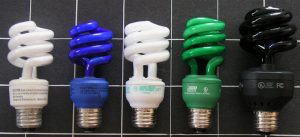
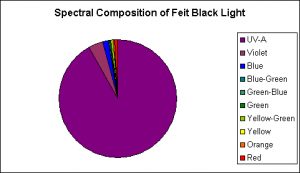
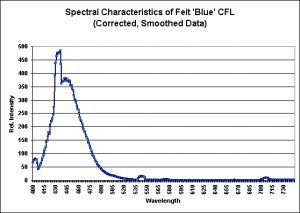
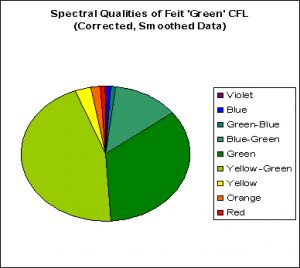

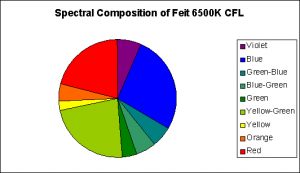
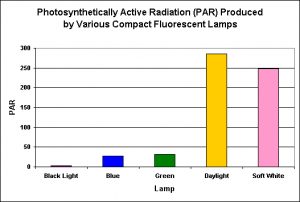
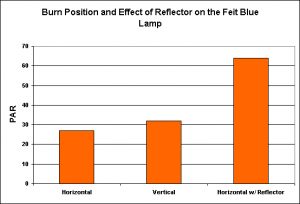
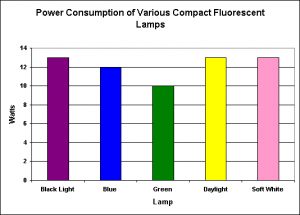

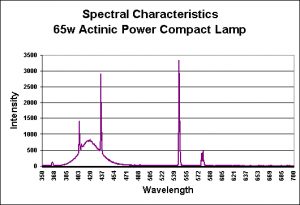

0 Comments